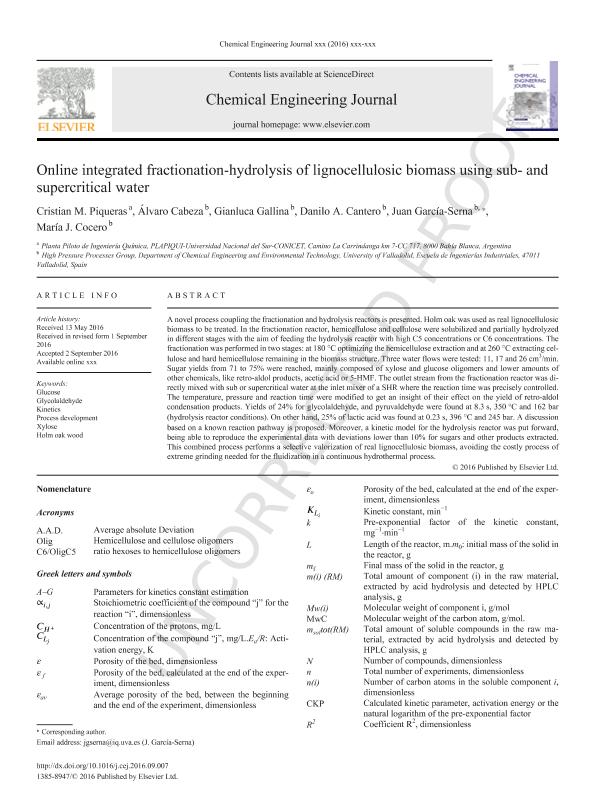Mostrar el registro sencillo del ítem
dc.contributor.author
Piqueras, Cristian Martin

dc.contributor.author
Cabeza, Alvaro
dc.contributor.author
Gallina, Gianluca
dc.contributor.author
Cantero, Danilo

dc.contributor.author
García Serna, Juan
dc.contributor.author
Cocero, María José

dc.date.available
2017-11-13T18:29:51Z
dc.date.issued
2016-09-03
dc.identifier.citation
Piqueras, Cristian Martin; Cabeza, Alvaro; Gallina, Gianluca; Cantero, Danilo; García Serna, Juan; et al.; Online integrated fractionation-hydrolysis of lignocellulosic biomass using sub- and supercritical water; Elsevier; Chemical Engineering Journal; 308; 3-9-2016; 110-125
dc.identifier.issn
1385-8947
dc.identifier.uri
http://hdl.handle.net/11336/28054
dc.description.abstract
A novel process coupling the fractionation and hydrolysis reactors is presented. Holm oak was used as real lignocellulosic biomass to be treated. In the fractionation reactor, hemicellulose and cellulose were solubilized and partially hydrolyzed in different stages with the aim of feeding the hydrolysis reactor with high C5 concentrations or C6 concentrations. The fractionation was performed in two stages: at 180ºC optimizing the hemicellulose extraction and at 260ºC extracting cellulose and hard hemicellulose remaining in the biomass structure. Three water flows were tested: 11, 17 and 26 cm3/min. Sugar yields from 71 to 75% were reached, mainly composed of xylose and glucose oligomers and lower amounts of other chemicals, like retro-aldol products, acetic acid or 5-HMF. The outlet stream from the fractionation reactor was directly mixed with sub or supercritical water at the inlet mixer of a SHR where the reaction time was precisely controlled. The temperature, pressure and reaction time were modified to get an insight of their effect on the yield of retro-aldol condensation products. Yields of 24% for glycolaldehyde, and pyruvaldehyde were found at 8.3 s, 350ºC and 162 bar (hydrolysis reactor conditions). In other hand, 25% of lactic acid was found at 0.23 s, 396ºC and 245 bar. A discussion based on a known reaction pathway is proposed. Moreover, a kinetic model for the hydrolysis reactor was proposed, being able to reproduce the experimental data with deviations lower than 10 % for sugars and other products extracted. This combined process performs a selective valorization of real lignocellulosic biomass, avoiding the costly process of extreme grinding needed for the fluidization in a continuous hydrothermal process.
dc.format
application/pdf
dc.language.iso
eng
dc.publisher
Elsevier

dc.rights
info:eu-repo/semantics/openAccess
dc.rights.uri
https://creativecommons.org/licenses/by-nc-sa/2.5/ar/
dc.subject
Glucose
dc.subject
Glycolaldehyde
dc.subject
Kinetics
dc.subject
Holm Oak Wood
dc.subject.classification
Otras Ingeniería Química

dc.subject.classification
Ingeniería Química

dc.subject.classification
INGENIERÍAS Y TECNOLOGÍAS

dc.title
Online integrated fractionation-hydrolysis of lignocellulosic biomass using sub- and supercritical water
dc.type
info:eu-repo/semantics/article
dc.type
info:ar-repo/semantics/artículo
dc.type
info:eu-repo/semantics/publishedVersion
dc.date.updated
2017-10-26T14:28:36Z
dc.journal.volume
308
dc.journal.pagination
110-125
dc.journal.pais
Países Bajos

dc.journal.ciudad
Amsterdam
dc.description.fil
Fil: Piqueras, Cristian Martin. Consejo Nacional de Investigaciones Científicas y Técnicas. Centro Científico Tecnológico Conicet - Bahía Blanca. Planta Piloto de Ingeniería Química. Universidad Nacional del Sur. Planta Piloto de Ingeniería Química; Argentina
dc.description.fil
Fil: Cabeza, Alvaro. Universidad de Valladolid. Facultad de Ciencias; España
dc.description.fil
Fil: Gallina, Gianluca. Universidad de Valladolid. Facultad de Ciencias; España
dc.description.fil
Fil: Cantero, Danilo. Universidad de Valladolid. Facultad de Ciencias; España
dc.description.fil
Fil: García Serna, Juan. Universidad de Valladolid. Facultad de Ciencias; España
dc.description.fil
Fil: Cocero, María José. Universidad de Valladolid. Facultad de Ciencias; España
dc.journal.title
Chemical Engineering Journal

dc.relation.alternativeid
info:eu-repo/semantics/altIdentifier/url/http://www.sciencedirect.com/science/article/pii/S1385894716312438
dc.relation.alternativeid
info:eu-repo/semantics/altIdentifier/doi/http://dx.doi.org/10.1016/j.cej.2016.09.007
Archivos asociados
